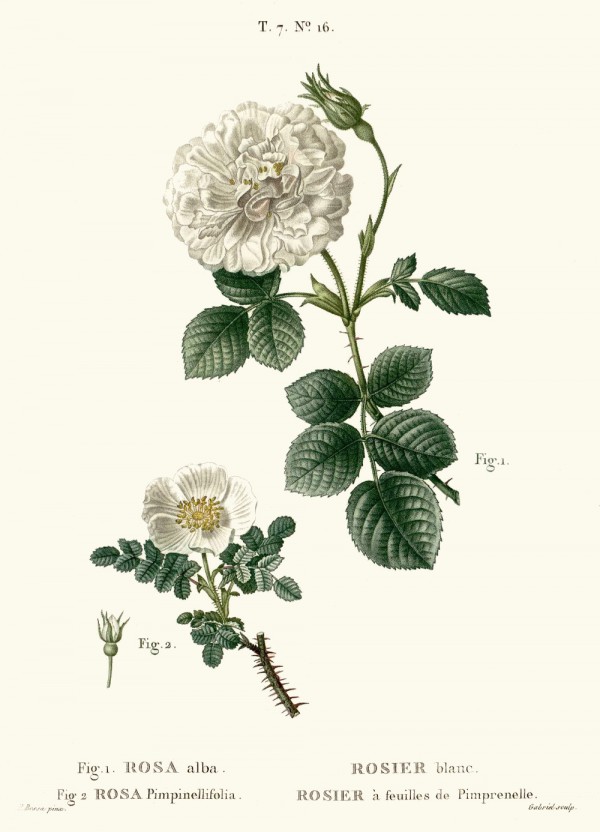Rosa alba L. - Rosaceae - white rose (of York), Weiße Rose, Alba-Rose
Shrub, up to 2m tall, only known in cultivation (old garden rose of the Greeks and Romans); prickles irregularly set on the stems, usually hooked and uniform; leaves with 5-7 leaflets, ovate to broadly elliptic, obtuse, simply serrate, glabrous above, paler, grey-green, ± hairy beneath; flowers solitary or 3(-5) rarely more, white or rarely pale pink, simple or usually double or semidouble, rarely simple, fragrant.
http://www.efloras.org/florataxon.aspx?flora_id=5&taxon_id=242345219
„… the classical European rose gardens were totally dominated until the beginning of the 19th century by the old famous fragrance roses Rosa alba, R.gallica, R.centifolia, and R.damascena…“
The scent of Rosa alba is based on citronellol (6.8%), nerol (10.2%), geraniol (17.0%), and 2-phenylethyl alcohol (16.9%). Further components are caryophyllene (23.0%), geranyl acetate (4.5%), α-pinene (3.0%), benzyl alcohol (2.5%), citronellyl acetate (0.4%), geranial (0.4%), neral (0.3%), cis-rose oxide (0.05%), trans-rose oxide (0.05%) eg.
[Meaningful Scents around the World, Roman Kaiser, Zürich 2006, 156-157, 253]
The essential oil of white oil-bearing roses (R. alba L.) from Bulgaria contained 214 compounds (GC-MS). The major part of the oil components were hydrocarbons like heneicosane (17.4%), nonadecane (15.0%), nonadecene (6.7%), tricosane (4.6%), pentacosane (1.4%) and heptacosane (1.6%). Major other components were citronellol (13.3%), geraniol (9.0%), nerol (4.3%), caryophyllene (3.0%), and farnesol (2.3%).
[Bulgarian rose oil of white oil-bearing rose., Nedkov, N., Dobreva, A., Kovacheva, N., Bardarov, V., Velcheva, A., Bulg J Agric Sci, 15, 2009, 318-322] http://www.agrojournal.org/15/04-07-09.pdf
In opening phase 4 (the flower is semi-opened, to see the stamens) oil content of Rosa alba flowers peaked at 0.028%. In phase 5 (flower is completely opened, the stamens are yellow) oil content was 0.020%.
The composition of the essential oil of the flowers of Rosa alba L. changed during flower opening. Whereas nonadecane (21-26%) and heneicosane (19-21%) dominated in phase 2 and 3 of flower developement, citronellol+nerol (21-22%) and geraniol (23-28%) were the main volatiles in stages 4 and 5. At this times, further components were ethanol (0.01-0.04%), linalool (1.6-2.0%), cis-rose oxide (0.02-0.04%), trans-rose oxide (0.03%), phenylethanol (0.02%), geranial (0.1-0.4%), β-damascenone (0.02-0.06%), β-caryophyllene (1.7-2.0%), geranyl acetate (0.3%), eugenol (0.3%), methyl eugenol (0.7%), heptadecane (5.1-5.6%), nonadecane (9.2-10.9%), eicosane (1.3-1.5%), heneicosane (9.5-11.0%), and tricosane (1.7-2.1%).
[Dobreva, A., & Gerdzhikova, M. (2013). Content and composition of the essential oil of Rosa alba L. during flower development. Agricultural Science & Technology (1313-8820), 5(1).] http://tru.uni-sz.bg/ascitech/1_2013/019%20Content%20and%20composition%20of%20the%20essential%20oil%20of%20Rosa%20alba%20L.%20during%20flower%20development.pdf

Duhamel du Monceau, H.L., Traité des arbres et arbustes, Nouvelle édition [Nouveau Duhamel], vol.7 t.16, fig. 1 (1819) [P. Bessa]
http://plantgenera.org/species.php?id_species=1259719

Rosa alba, CC BY-SA 3.0, Author: Andreas Kraska
